Detroit’s Grand New Showplace Of Krsna Culture
At the famous Lawrence P. Fisher Mansion, Indian spirituality and American ingenuity unite for the glorification of Lord Krsna.
by Madhyama-devi dasi
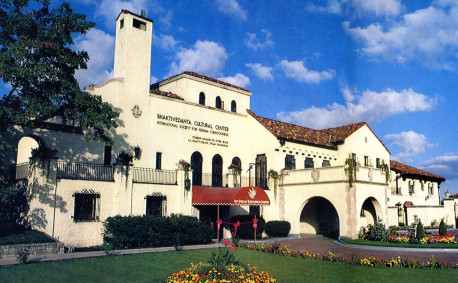
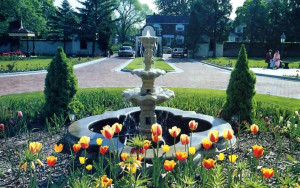
The setting for the party was perfect. In fact, the setting seemed to be what the occasion was all about. The grand opening of the Bhaktivedanta Cultural Center, located on the richly landscaped four-and-a-half acres of Detroit’s famous Lawrence P. Fisher Mansion, even drew the attention of the Michigan State Senate, which passed a resolution thanking the guests of honor, Alfred Brush Ford (Ambarisa dasa) and Elisabeth Reuther Dickmeyer (Lekhasravanti-devi dasi) for contributing the funds that made the center a reality. The party was a tremendous success; there was no doubt about that.
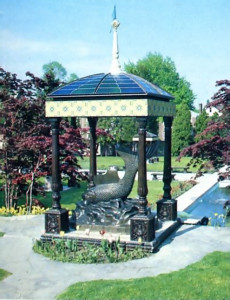
And who would have expected the simultaneous and amicable appearance of members of the traditionally feuding Ford and Reuther families? A fascinating variety of people—billionaires and brahmacaris, capitalists and craftsmen, Indian diplomats and American brahmanas, and the cream of Detroit’s society-page personalities—all received their fragrant garlands at the massive, ornately carved front doors and went on to enjoy the ceremony, the museum exhibitions, and the eighteen-course feast of sanctified vegetarian food.
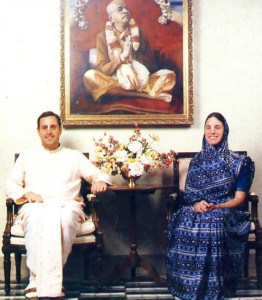
The media, of course, turned out in force. As I read over the published reports and listened to the newscasts, I was encouraged by the amount of coverage and astounded at the wealth of detail. The beautiful formal gardens, in which peacocks wandered amid fountains, pools, and sculptures, the Moorish architecture of the mansion, with its handmade tiles, intricate rosewood and mahogany carvings, gold-and-silver-leafed ceilings, all restored in authentic detail and further enhanced by the newly finished multimedia exhibition—the press reports missed nothing of this.
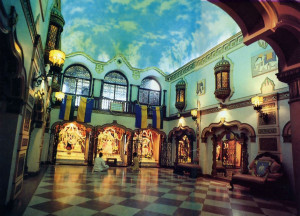
But while the coverage was lavish and (for the most part) favorable, I gradually began to feel that the reporters had missed the most amazing fact about the opening of the Bhaktivedanta Cultural Center: The dozens of people who had spent two and a half million dollars and nearly a decade of their lives to build it didn’t expect to make a dime off it.
What motivated them to make such a tremendous sacrifice of their talents and wealth? Why did they do it?
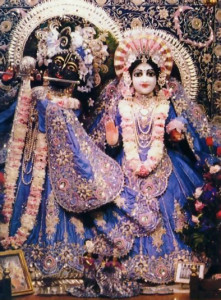
It’s only human nature to assume that what motivates us must also be motivating others. Thus one major newspaper pegged the International Society for Krishna Consciousness as a kind of “evangelical Am-way,” an organization of former radical street beggars who’ve evolved into rational, middle-aged, middle-class, family-raising citizens—the underlying assumption being, of course, that affluence and bodily comfort are really what life is all about and that the Hare Krsnas, beneath their veneer of odd dress and strict lifestyle, must really believe this as much as everyone else does.

Nothing could be further from the truth. And the best way to prove this, I feel, is to let the people responsible for the Bhaktivedanta Cultural Center speak for themselves.
The first person to inquire from, of course, should be the person whom the center is named after: His Divine Grace A.C. Bhaktivedanta Swami Prabhupada. Without question, Srila Prabhupada played the most important role in the center’s completion. Back in 1975, it was he who first saw the potential of the then run-down building on Detroit’s rough East Side. He personally negotiated the purchase price, and he inspired Ambarisa and Lekhasravanti to purchase and develop the mansion as a showplace of Krsna consciousness. And finally, he had the vision to create the First American Transcendental Experience, FATE, the group of devoted artists who constructed a multi-media museum, first in Los Angeles and now in Detroit.

Although Srila Prabhupada passed away in 1977, we can derive the benefit of his personal presence by hearing his teachings. He continues to speak to us today, meaningfully and succinctly, through the medium of his published works.
In his translation, with commentary, of the Srimad-Bhagavatam, Srila Prabhupada explains that mankind is fast entering a spiritual void and is thus in desperate need of “a cultural presentation for the respiritualization of the entire human society.”

A cultural presentation. Music, dance, painting, sculpture, film—the world has plenty of culture already. Why then did Srila Prabhupada want to make another cultural presentation? How was this cultural presentation going to do what other cultural presentations couldn’t—namely, respiritualize the entire human society?
Srila Prabhupada explains that the ideal culture is one that reminds us of God—that encourages us to learn about Him, love Him, and serve Him. And that culture is being presented by the Bhaktivedanta Cultural Center.
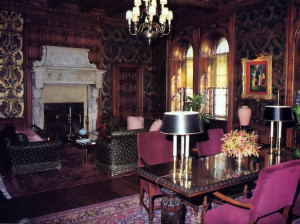
Adi-deva dasa, the director of FATE, explained to me that the spiritual ideals he learned from Srila Prabhupada have grown stronger with time and with his mature experience as a devotee-artist.
“Nothing is impossible in spiritual life,” he said. “Srila Prabhupada told us, in fact, that impossible is a word in a fool’s dictionary. Srila Prabhupada sent us to India to be trained in a special method of figure sculpture known only in Bengal. It was austere, of course, living in a straw hut with the mosquitoes. And our years in Los Angeles, trying to get a studio started—marathon, round-the-clock work sessions to meet deadlines—no one could say it was easy.
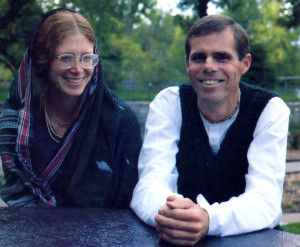
“All of our talent and energies went into making these exhibits. But the greatest happiness an artist can feel is to have a meaningful outlet for his skills. And the greatest happiness a spirit soul can feel is to use the gifts Krsna has given him to glorify the giver Himself. This is a happiness that transcends the bodily situation, and because we’ve felt it, we want to give it to others.

“Srila Prabhupada gave all of his energies to translating the Srimad-Bhagavatam for us. So the exhibits in the Bhaktivedanta Cultural Center are all based on this scripture. Everyone who sees them is learning about spiritual life. Srila Prabhupada wrote me a letter explaining the potency of what he called ‘these living hooks.’ He said, ‘In London there is a museum—Madame Tussaud’s Wax Museum—and people are lining up for blocks just to see some mundane dead bodies. You should go to India and learn how to make dolls. Then we will have our own museum, and simply by seeing our exhibits people will make spiritual advancement.’
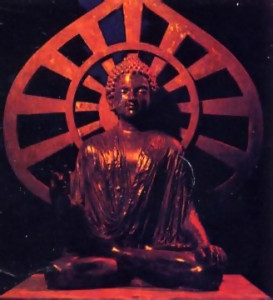
“I’ve personally taken hundreds of people through the museum. Everyone who’s gone through has gotten a better understanding of the philosophy of Krsna consciousness, as well as transcendental pleasure from seeing Krsna’s beauty portrayed through art. Srila Prabhupada has given us the most wonderful gift. We’re doing our best to pass it on.”

Ambarisa dasa, great-grandson of Henry Ford, donated most of the money that developed the Bhaktivedanta Cultural Center. When I asked him why he’d done it, he said it was simply because Srila Prabhupada had asked him to.
“I was traveling in India with Srila Prabhupada,” he said, “when he first told me we could ‘conquer’ the West by Vedic culture. Personally, I was eager to spread Krsna consciousness among the class of people I knew and grew up with. I felt there had to be a way to do it, some way to tell them about our philosophy that they could relate to. Srila Prabhupada was giving me the clue.

“When Lekhasravanti [the daughter of the late Walter Reuther] and I purchased the Fisher Mansion in 1975. Srila Prabhupada told us we should make it into ‘a gorgeous showplace of Krsna conscious culture.’ He felt that although the mansion had been built for material reasons, simply by being used to house the FATE exhibits, which all center on Krsna, it would become spiritualized.
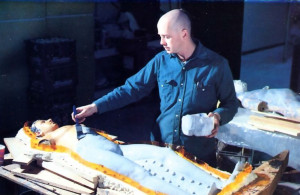
from fetus to corpse-and to a new body.
“The grand opening has proven Srila Prabhupada right. My parents attended, and many friends of my family. Everyone there was satisfied. They weren’t in the least bit turned off or skeptical.
“I can understand now why Srila Prabhupada told me, ‘These exhibits will revolutionize our preaching in the West.'”

Lekhasravanti stood before the audience of some three hundred fifty distinguished guests at the ribbon-cutting ceremony, listening to the speeches made by the other noteworthy persons, patiently waiting her turn. Nearly everyone knows that she contributed half the purchase price of the Fisher Mansion back in 1975. Few know that it took virtually her entire savings to do so. As she spoke, I felt that her simple statement represented the attitude of so many other devotees—cooks, gardeners, waiters, carpenters, painters, window-washers, floor-moppers—everyone who gave freely, no matter how seemingly unnoticed the gift, to complete the Bhaktivedanta Cultural Center.
“Srila Prabhupada gave us all a wonderful gift—the gift of Krsna conscious philosophy, that loving God will make us happy. We just want to share this happiness with the people of Detroit.”
Highlights from the Opening

• The Michigan State Senate resolution read at the ribbon-cutting ceremony called the grand opening of the Bhaktivedanta Cultural Center at the Lawrence P. Fisher Mansion “a momentous occasion for glad rejoicing. . . . The center is awe-inspiring. . . . We are proud that it is available to the people of Detroit.”

• Srila Ramesvara Swami, who, with Srila Bhavananda Goswami Visnupada, oversaw the completion of the center, spoke of the wealth of architectural craftsmanship displayed by the Fisher Mansion, including Govinda’s vegetarian restaurant, which is finished in elegant Italian Renaissance decor. He also described the multimedia FATE museum, with its electronically coordinated exhibits depicting themes from Vedic scripture; the grounds, with their fountains, gardens, strutting peacocks, and sculptured renditions of divine incarnations; the auditorium, which will be used for presenting the best in Indian classical music, dance, and drama; the painting exhibit, which contains the finest examples of Indian and Western Krsna conscious art; and, most important, the Bhakti-Yoga Center, where people can take free classes in the highest spiritual science India has to offer—the science of devotional service to Krsna.
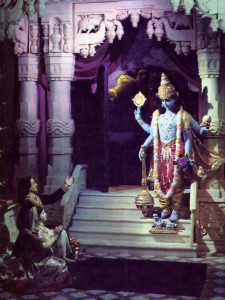
• Srila Visnupada spoke of the soon-to-be-inaugurated Food for Life program. “It’s such a shame that in such an affluent society as ours, anyone should have to go hungry. Srila Prabhupada told us that no one within a ten-mile radius of any ISKCON temple should ever lack for food. So, besides our regular, traditional free Sunday feasts, we’re going to start giving out free meals of krsna-prasadam [food offered to Krsna] to all comers during the week as well.”
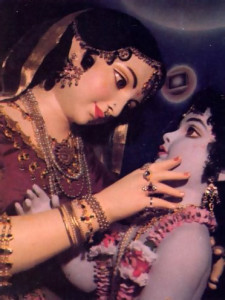
Srila Visnupada also said that Srila Prabhupada wanted the Detroit cultural center to be a showcase for the blending of American technology and Indian spiritual science. “A lame man riding on a blind man’s shoulders is able to get around, while the blind man can benefit from the lame man’s directions. Similarly, the less materially well-off nation of India can give spiritual eyes to vigorously wealthy but spiritually blind America. This partnership is of great benefit to the people of both nations.”
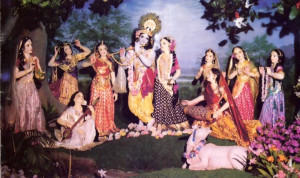
• In a letter to Lekhasravanti, Michigan Governor James J. Blanchard wrote, “I wish you and the other members of the Krishna society every success on this great occasion. The restored Fisher Mansion and the cultural center are an ornament to the neighborhood . . . . I hope they will serve as a catalyst for renewal, not only physical but spiritual.”

My dear Madhyama-devi dasi—
How can you state on your website http://back2godhead.com/spiritual-places-4/, The Magazine of the Hare Krishna Movement—that “the Lawrence P. Fisher Mansion had suffered from neglect until devotees of Krsna restored it to its original splendor…” or “Back in 1975, it was he (Srila Prabhupada) who first saw the potential of the ‘then run-down building’ on Detroit’s rough East Side.
How can you speak or write such blatant untruths of the Fisher mansion at that time?
When Srila Prabhupada met with us in the summer of 1975, the Fisher mansion was in excellent condition; the total façade had been recently painted, the interior was in pristine condition and the gardens were expertly maintained and groomed. Time-Life Sports Illustrated magazine had only shortly before rented the entire Fisher mansion for a thank-event for their advertisers. I’m sure, you would agree, they would never have done that if, in fact, it “suffered from neglect” or was “the run-down building” you purported it to be.
While I applaud the fact that you have maintained the building to the best of your ability and have tried to repair the damage that it has incurred since it was purchased, I ask that you stop referring to it when purchased as Neglected and Run-down. I repeat, that it was in excellent condition when Srila Prabhupada met with my husband and me, and was turned over to ISKCON in excellent condition. My husband, Gilbert Groehn, had deep respect for ISKCON and was always dismayed about being depicted as a type of Slum Lord.
Sincerely, Nancy Groehn